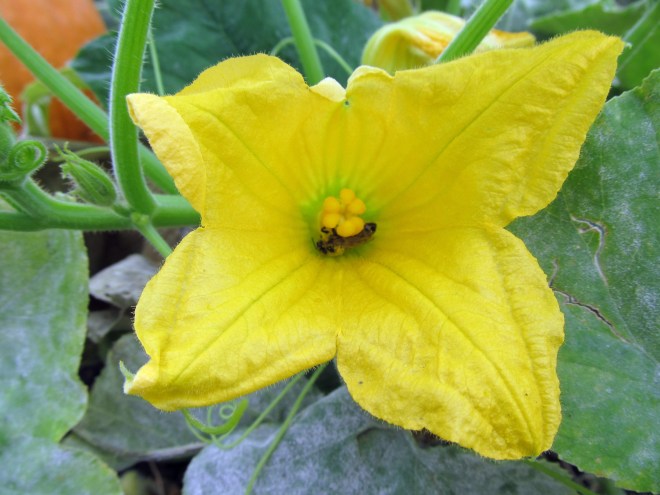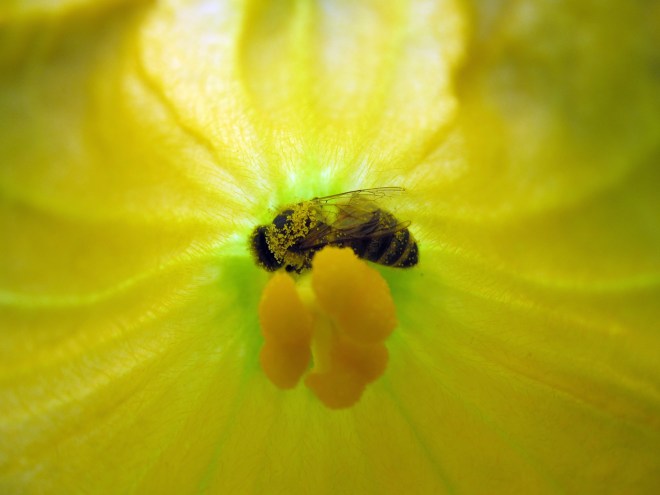Because of their large, open, unisexual flowers, plants in the gourd family are perfect for practicing hand pollination. There are several species in this family that are commonly grown in gardens, and all can be hand pollinated. Hand pollination of cucurbits is most often done when there are problems with pollination (lack of pollinators, etc.) or for seed saving purposes (i.e. to ensure that a variety breeds true). It can also be done just for fun, and that’s mostly what this post is about.
But first, if your goal is to save seeds and maintain the integrity of the varieties you are growing, there are a few things to keep in mind. Cucumbers, melons, and watermelons are all different species (Cucumis sativus, Cucumis melo, and Citrullus lanatus respectively), so you won’t have to worry about crosses between these crops. You will, however, have to worry about crosses between different varieties within individual species. So, for example, if you are growing multiple varieties of cucumbers – or if your close neighbors are also growing cucumbers – you should hand pollinate. Summer squash, winter squash, pumpkins, and some gourds are members of at least four species in the genus Cucurbita (C. pepo, C. maxima, C. mixta, and C. moschata). There is a possibility of hybridization between some of these species as well as between varieties within the same species, so precautions should definitely be taken when saving seeds for these crops. This can mean, along with hand pollination, placing bags over flowers so that bees are unable to bring in pollen from “the wrong” plants.
There are plenty of great resources about saving seeds that offer much more detail than I have gone into here, one of which is a book by Marc Rogers called Saving Seeds. Consult such resources if you would like to try your hand at seed saving. It’s easier than you might think, and it’s very rewarding.
Regardless why you are hand pollinating your cucurbits, the first step in the process is differentiating a male flower from a female flower. This is simple. Female flowers in the family Cucurbitaceae have inferior ovaries, meaning that the ovary sits below the area where the petals and other flower parts are attached. The ovaries are quite pronounced and resemble a miniature fruit. The male flowers lack ovaries, so instead are simply attached to a slender stem. You can also observe the sex organs themselves – male flowers have stamens, female flowers have carpels. Male and female flowers may also be located on different areas of the plant and may open at different times of the day. All that being said, the most obvious indication is the “mini-fruit” at the base of the flower or lack thereof.

Cucurbit flowers: male (top two photos) and female (bottom two photos) – image credit: wikimedia commons
Once you have identified your flowers, you have a limited amount of time to hand pollinate them. It’s best to find flowers that are just starting to open, as the female flowers may only be receptive for as little as 24 hours. You can use a cotton swab to gather pollen from the male flower, or you can simply pluck the flower from the plant, remove the petals, and touch the pollen-loaded anthers to the stigmas of a female flower. Either way, you must get the pollen from the male parts of a flower to the female parts of a flower as that is the essence of pollination. Simply put, it’s plant sex. Play some soft jazz while you do it if you want to.
As with saving seeds, there are a lot of resources out there explaining the details of hand pollinating cucurbit flowers, including this guide from Missouri Botanical Garden and the following You Tube Video.
While we are on the subject of cucurbit flowers, it should be noted that squash flowers are edible and can be prepared in a variety of ways, as described in this post at The Kitchn. Just another reason to be impressed by this amazing group of plants.



Pingback: 2015: Year in Review | awkward botany